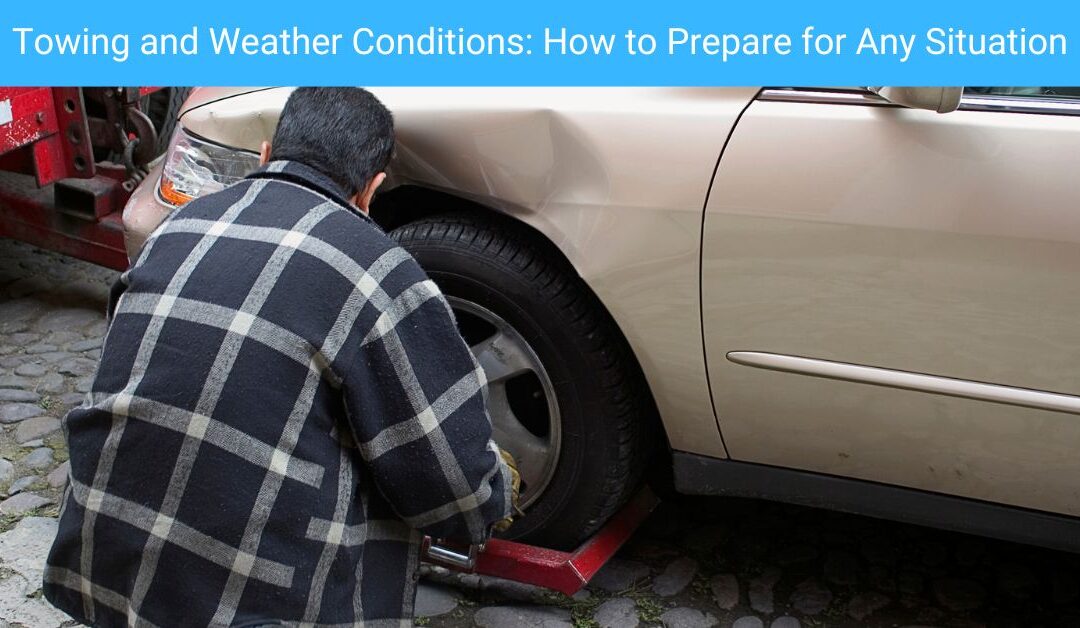When it comes to towing vehicles, weather conditions can play a crucial role in determining the safety and effectiveness of the operation. Whether it’s a snowstorm, heavy rain, or extreme heat, towing in adverse weather presents unique challenges that require careful planning and preparedness. As a driver or towing professional, understanding how to prepare for these conditions can help ensure the safety of both the vehicle being towed and everyone involved in the process.
Understanding the Impact of Weather on Towing
Each type of weather condition has its own set of challenges when it comes to towing. In cold weather, freezing temperatures can cause mechanical problems in both the towed vehicle and the tow truck. For instance, frozen brake lines or low tire pressure can create serious hazards. On the other hand, heavy rain or fog can reduce visibility, making it difficult for the tow truck driver to navigate roads safely. Extreme heat can cause tires to overheat, and road surfaces may become slippery due to oil buildup, making it more challenging to maintain control of the towing operation. Therefore, understanding how weather can affect both your vehicle and the towing equipment is the first step in ensuring a safe and efficient tow.
Preparing Your Tow Truck for Extreme Conditions
The tow truck itself needs to be in top condition before heading out in any weather condition. Regular maintenance is essential, but it becomes even more critical when weather conditions are unpredictable. In cold weather, ensure that the truck’s battery is fully charged, and check that the antifreeze levels are sufficient to prevent the engine from freezing. For hot weather, make sure the cooling system is functioning properly to avoid the engine overheating. It’s also essential to inspect the truck’s tires and brakes, as they can be affected by extreme temperatures. Moreover, making sure that your truck has high-quality, functional tires designed for the expected weather conditions will help prevent accidents or delays.
Adjusting Towing Techniques for Weather Conditions
When towing a vehicle in adverse weather, it’s important to adjust your towing techniques to account for the impact of the conditions. In snowy or icy conditions, it’s crucial to drive at a slower speed to prevent losing control. If the road is slippery, ensure that your towing vehicle is equipped with proper traction aids such as chains or snow tires. Towing a vehicle uphill or over icy surfaces may require more careful acceleration and braking to avoid skidding. In rain, reduce your speed, and maintain a larger distance between the tow truck and the vehicle being towed to allow more time to react if the road is slick. Visibility issues such as heavy fog or rain require the use of fog lights or additional lighting to ensure the safety of both the towed vehicle and the tow truck.
Safety Precautions for the Vehicle Being Towed
The vehicle being towed also needs special attention, especially in extreme weather. Before towing in icy conditions, ensure that the vehicle’s emergency brake is disengaged, and check that the tow bar is securely attached. In hot weather, overheating is a significant concern. If the car has been sitting idle for a while, make sure it’s in good running condition before towing, and be aware that excessive idling can damage the engine or other components. If towing in rainy conditions, check that all electrical components, including lights and brakes, are functioning properly on the towed vehicle. It’s also important to monitor the condition of the tires; any wear or damage can worsen under wet or snowy conditions, increasing the risk of accidents.
Communication and Preparedness for Unexpected Situations
Towing in adverse weather often requires more communication and readiness to handle unexpected challenges. Always inform the towing company of the weather conditions before sending a tow truck to the scene, so they can send the most appropriate vehicle and equipment. If you are towing a vehicle on your own, make sure to have a reliable GPS system or map that accounts for road closures or hazards caused by the weather. Carry an emergency kit with essential items such as blankets, water, food, and a flashlight in case of delays due to weather conditions. It’s also advisable to have a plan for communicating with emergency services or roadside assistance if the situation escalates or the weather worsens unexpectedly.
Conclusion
Towing in adverse weather requires careful planning, equipment preparation, and a solid understanding of how different conditions impact both the towing vehicle and the car being towed. By ensuring that both the tow truck and the towed vehicle are properly maintained and by adjusting towing techniques to match the weather conditions, you can significantly reduce the risks associated with towing in challenging weather. Preparation, communication, and safety awareness are key to navigating any towing situation, whether it involves snow, rain, heat, or fog. With the right approach, you can handle any weather-related towing challenge that comes your way.
If you are in Narre Warren, Victoria 3805, Australia, and looking for a car removal service, this is the best way to visit us.
Contact Us
Berwick Towing & Transport
27B William Rd
Berwick VIC 3806
(03) 7035 7815
www..berwick-towing.com.au/

